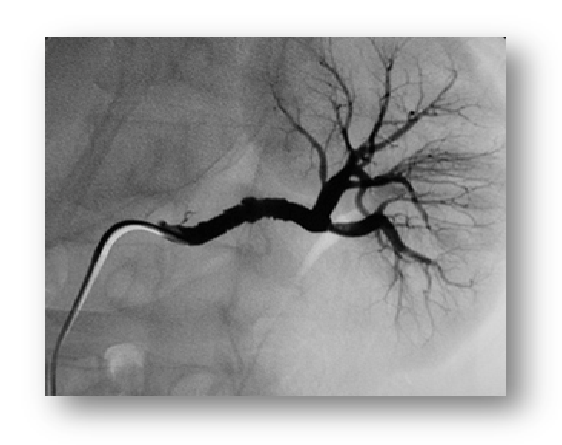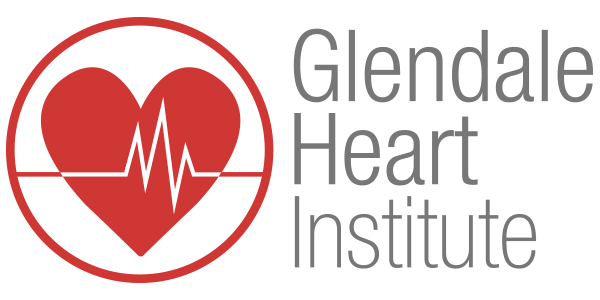Renal arteriography is a special x-ray of the blood vessels of the kidneys.Renal arteriography is also called renal angiography.
How the Test is Performed
This test is done in the hospital. You will lie on an x-ray table.The health care provider will clean and shave the area of the body (usually near the groin) and apply numbing medicine to the area. A needle is placed into to the artery. Once the needle is in the proper position, a thin wire passes through it. The needle is taken out, and a long, narrow, flexible tube called a catheter is put in its place. An instrument called a fluoroscope sends x-ray images of the body to a TV monitor. The images help the radiologist guide the catheter into the right position. The catheter runs over the wire and is pushed up through the main blood vessels of the pelvis into the aorta (the main blood vessel running down from the heart to the lower body).
The test uses a special dye (called “contrast medium”) to help the arteries show
How the Test is Performed
This test is done in the hospital. You will lie on an x-ray table.The health care provider will clean and shave the area of the body (usually near the groin) and apply numbing medicine to the area. A needle is placed into to the artery. Once the needle is in the proper position, a thin wire passes through it. The needle is taken out, and a long, narrow, flexible tube called a catheter is put in its place. An instrument called a fluoroscope sends x-ray images of the body to a TV monitor. The images help the radiologist guide the catheter into the right position. The catheter runs over the wire and is pushed up through the main blood vessels of the pelvis into the aorta (the main blood vessel running down from the heart to the lower body).
The test uses a special dye (called “contrast medium”) to help the arteries show

up better on the x-ray. The blood vessels of the kidneys cannot be seen with ordinary x-rays. The dye flows through the catheter into the kidney artery.
X-ray images are taken as the dye moves through the blood vessels. Saline (sterile salt water) containing a blood thinner may also be sent through the catheter to keep blood in the area from clotting.
A computer may be used to “subtract” out the bones and tissues in the area so that only the blood vessels filled with the dye can be seen. This is called digital subtraction angiography (DSI).
The catheter is removed after the x-rays are taken. Pressure is immediately applied to the area for 10 to 15 minutes or more to stop the bleeding. After that time, the area is checked and a bandage is applied. You should keep your leg straight for 6 hours after the procedure.
How to Prepare for the Test
Tell the health care provider if:
• You are pregnant
• You have ever had any bleeding problems
• You currently take blood thinners, including daily aspirin
• You ever had any allergic reactions, especially those related to x-ray contrast material or iodine substances
You must sign a consent form. Do not eat or drink anything for 8 hours before the test. You will be given a hospital gown to wear and asked to remove all jewelry. You may be given a sedative or pain pill before the procedure.
How the Test Will Feel
The x-ray table is hard and cold. You may wish to ask for a blanket or pillow.
Some people feel a sting when the anesthetic (numbing medicine) is given. You will feel a brief, sharp pain as the catheter is inserted. There is a feeling of pressure as the catheter is moved into the body.
Some people feel a warm or burning sensation when the dye is injected. There may be slight tenderness and bruising at the site of the injection after the test.
Why the Test is Performed
The test is done to look at the blood vessels that feed the kidney. It may show:
• Aneurysm (a widening of the vein or artery)
• Abnormal connections between veins and arteries (fistulas)
• Blood clots
• Kidney disease or failure
• Narrowing of the blood vessels of the kidneys (renal stenosis)
Risks
The procedure is generally safe, but risks may include:
• Allergic reaction to the dye (contrast medium)
• Arterial occlusion from dissection
• Damage to artery or artery wall, which can lead to blood clots
There is low radiation exposure. However, most experts feel that the risk related to most x-rays is smaller than other risks we take every day, such as driving in cars. Pregnant women and children are more sensitive to the risks related to x-rays.
X-ray images are taken as the dye moves through the blood vessels. Saline (sterile salt water) containing a blood thinner may also be sent through the catheter to keep blood in the area from clotting.
A computer may be used to “subtract” out the bones and tissues in the area so that only the blood vessels filled with the dye can be seen. This is called digital subtraction angiography (DSI).
The catheter is removed after the x-rays are taken. Pressure is immediately applied to the area for 10 to 15 minutes or more to stop the bleeding. After that time, the area is checked and a bandage is applied. You should keep your leg straight for 6 hours after the procedure.
How to Prepare for the Test
Tell the health care provider if:
• You are pregnant
• You have ever had any bleeding problems
• You currently take blood thinners, including daily aspirin
• You ever had any allergic reactions, especially those related to x-ray contrast material or iodine substances
You must sign a consent form. Do not eat or drink anything for 8 hours before the test. You will be given a hospital gown to wear and asked to remove all jewelry. You may be given a sedative or pain pill before the procedure.
How the Test Will Feel
The x-ray table is hard and cold. You may wish to ask for a blanket or pillow.
Some people feel a sting when the anesthetic (numbing medicine) is given. You will feel a brief, sharp pain as the catheter is inserted. There is a feeling of pressure as the catheter is moved into the body.
Some people feel a warm or burning sensation when the dye is injected. There may be slight tenderness and bruising at the site of the injection after the test.
Why the Test is Performed
The test is done to look at the blood vessels that feed the kidney. It may show:
• Aneurysm (a widening of the vein or artery)
• Abnormal connections between veins and arteries (fistulas)
• Blood clots
• Kidney disease or failure
• Narrowing of the blood vessels of the kidneys (renal stenosis)
Risks
The procedure is generally safe, but risks may include:
• Allergic reaction to the dye (contrast medium)
• Arterial occlusion from dissection
• Damage to artery or artery wall, which can lead to blood clots
There is low radiation exposure. However, most experts feel that the risk related to most x-rays is smaller than other risks we take every day, such as driving in cars. Pregnant women and children are more sensitive to the risks related to x-rays.
Cardiac Specialty Care
• Structural Heart Disease
• TAVR
• CardioMEMS (Heart Failure)
• PFO Closure
• TAVR
• CardioMEMS (Heart Failure)
• PFO Closure
• Coronary Intervention
• Complex Higher-Risk (And Indicated) Patients (CHIP) Angioplasty
• Atherectomy
• Impella and ECMO Support
• Complex Higher-Risk (And Indicated) Patients (CHIP) Angioplasty
• Atherectomy
• Impella and ECMO Support
• Peripheral Angioplasty
• Varicose Vein Treatment (Venous Ablation)
• DVT thrombectomy - IVC filter
• Carotid Stenting
• Varicose Vein Treatment (Venous Ablation)
• DVT thrombectomy - IVC filter
• Carotid Stenting
• Rhythm Management
• Pacemaker
• Holter Monitoring
• Exercise Stress Test
• Echocardiography
• Nuclear Stress Test
• Enhanced External Counterpulsation (EECP)
• Pacemaker
• Holter Monitoring
• Exercise Stress Test
• Echocardiography
• Nuclear Stress Test
• Enhanced External Counterpulsation (EECP)
